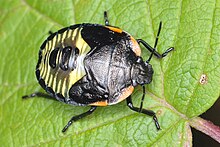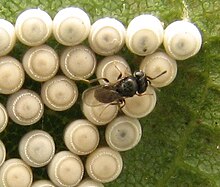| Green stink bug | |
|---|---|

| |
| Scientific classification | |
| Domain: | Eukaryota |
| Kingdom: | Animalia |
| Phylum: | Arthropoda |
| Class: | Insecta |
| Order: | Hemiptera |
| Suborder: | Heteroptera |
| Family: | Pentatomidae |
| Genus: | Chinavia |
| Species: | C. hilaris |
| Binomial name | |
| Chinavia hilaris Say, 1832 | |
| Synonyms | |
| |
The green stink bug or green soldier bug (Chinavia hilaris) is a stink bug of the family Pentatomidae.
Taxonomy

The species was previously placed in the genus Acrosternum but has been classified as in the genus Chinavia in the more recent literature (e.g., Schwertner and Grazia, 2006). However, the Entomological Society of America has not officially recognized this change despite this shift in scientific naming.
Description

The green stink bug's color is typically bright green, with narrow yellow, orange, or reddish edges. It is a large, shield-shaped bug with an elongate, oval form and a length between 13 and 18 mm. It can be differentiated from the species Nezara viridula by its black outermost three antennal segments. Its anterolateral (= in front and away from the middle) pronotal margin is rather straight and not strongly arced such as in Chinavia pensylvanica. Both adults and nymphs have large stink glands on the underside of the thorax extending more than half-way to the edge of the metapleuron. They discharge large amounts of this foul-smelling liquid when disturbed. This liquid, dried and pulverized, was once used at industrial level to reinforce the smell of some acids. Now it's been replaced by artificial composites.
Habitat
This species is found in orchards, gardens, woodlands and crop fields throughout North America, feeding with their needle-like mouthparts on the juices of a wide variety of plants from May until the arrival of frost. Their range spans from the eastern United States, from New England to Florida, to the 98 degree west longitudinal line; they are also seldom found anywhere west of this boundary, though are found moderately along the west coast, from San Diego, California to Seattle, Washington. Adults develop a preference for developing seeds and thus become crop pests (tomato, bean, pea, cotton, soybean, eggplant). When no seeds are present, they also feed on stems and foliage, thus damaging several fruit trees, such as the apple, cherry, orange and peach trees.
Green stink bugs frequent noncrop hosts more than other stink bug species earlier in the season. Plants such as black cherry, elderberry, mimosa and pecan exist as farmscape edges, which provide immature organisms a safe location to develop and a gateway to agricultural fields. Unlike cotton, peanuts and corn are not considered host crops, and the last has been shown to slow dispersion of green stink bug to nearby host crops due to its tall field edges.
Life cycle

Adults appear in the field early September and become plentiful in sheltered positions. Then, mating happens in early October and finally, the eggs can be found mid to late October. Nymphs appear in late October and early November. Two or three generations occur in the summer months in the field and in the laboratory at 26 °C.
Reproduction
The adult females attach their keg-shaped eggs on the underside of foliage in double rows of twelve eggs or more. These clusters appear almost cylindrical, and they transition from light green, to yellow, to light pink as organisms approach hatching. Time from egg deposition to hatch decreases with rises in temperature. The green stink bug produces one generation in the North and two generations in the South. The early instar nymphs are rather brightly colored and striped, turning green when approaching adulthood. The eggs are usually laid in clusters of 14 (some clusters contain fewer eggs, with 9 being the smallest number recorded out of 77 observations). The eggs are laid either on the undersurfaces of leaves or on the stems of plants or on the flowers of salvia.
Agricultural impact

The green stink bug is considered to be a pest of economic importance in the United States. Crops are considered to be damaged when plant tissue is split by the feeding stylet. Most damage is administered by adults; effects can include catfishing (the misshaping of plant tissue, creating rough and corky edges) in peaches, internal warts and stained lint within cotton, green stem syndrome in soybeans and white spongy areas on tomatoes. Any dimples or scars on fruit are most likely administered by nymphs. On occasion, the laying of eggs on grapes causes said nymphs to deplete the juices from the growing fruits.
Pest management
This stink bug species is parasitized by the tachinid fly Trichopoda pennipes and by parasitic wasps.
The green stink bug uses the pheromone methyl (E,Z,Z)-2,4,6-decatrienoate in its communication system and this may be used to attract the bug away from crop fields.
See also
References
- Kamminga, K.L.; et al. "Biology and Management of the Green Stink Bug". Journal of Integrated Pest Management. Retrieved 6 December 2021.
- "Chinavia hilaris (Say, 1831)". North Dakota State University.
- "Observations". iNaturalist.
- Cottrell and Tillman, T. and P. Glynn (2015). "Spatiotemporal Distribution of Chinavia hilaris (Hemiptera: Pentatomidae) in Corn Farmscapes". Journal of Insect Science. 15: 28. doi:10.1093/jisesa/iev017. PMC 4535476. PMID 25843581.
- ^ McDonald, F. J. D. (1971). "Life Cycle of the Green Stink Bug Plautia Affinis Dallas (Hemiptera: Pentatomidae)". Australian Journal of Entomology. 10 (4): 271–275. doi:10.1111/j.1440-6055.1971.tb00040.x.
- "EENY-431/IN794: Green Stink Bug, Chinavia hilaris (Say) (Insecta: Hemiptera: Pentatomidae)". edis.ifas.ufl.edu.
- Susan Mahr. "Trichopoda pennipes". University of Wisconsin-Madison. Archived from the original on 2013-01-13. Retrieved 2008-03-18.
- Species Trissolcus euschisti
- The Pherobase. "Semiochemical – me-E2Z4Z6-decatrienoate". Pest Management Information System. Retrieved 2008-03-18.
Sources
- Chinavia hilaris BugGuide. Iowa State University Entomology. Retrieved 6 October 2010.
- Lorus and Margery Milne : National Audubon Society : Field Guide to North American Insects and Spiders; Alfred A. Knopf, New York, fourteenth printing, 1996; ISBN 0-394-50763-0
- McPherson, J.E. (1982). The Pentatomoidea (Hemiptera) of Northeastern North America. Southern Illinois University Press. ISBN 978-0-8093-1040-1.
- Schwertner, C. F. and J. Grazia. 2006. Descrição de seis espécies de Chinavia (Hemiptera, Pentatomidae, Pentatominae) da América do Sul. Iheringia (Zool.) 96(2): 237–248.
External links
- Chinavia hilaris, green stink bug on the University of Florida / Institute of Food and Agricultural Sciences Featured Creatures website
| Taxon identifiers | |
|---|---|
| Acrosternum hilare | |